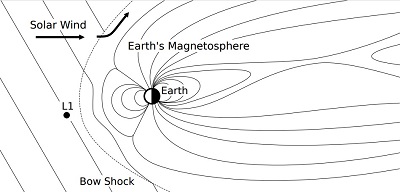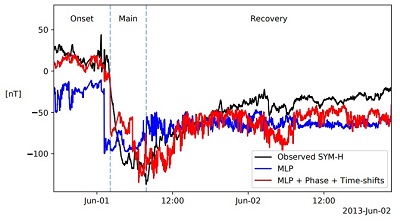Jacques Beukes of the MUST Deep Learning research group at the Faculty of Engineering is the 2021 winner of a North-West University (NWU) Vice-Chancellor’s Medal for his dissertation “Interpretability of deep neural networks for SYM-H prediction”. Eight vice-chancellor’s medals are awarded annually to the best master’s-degree students at the NWU. Jacques was awarded the medal for Engineering. The awards are given in recognition of excellent work done by master’s-degree students at the NWU, and to celebrate the continued efforts of study leaders and other academics in creating and sustaining a nurturing environment for these students.
Jacques’s study was a collaborative effort between MUST and the South African National Space Agency (SANSA). MUST director Prof Marelie Davel was his supervisor, with co-supervision provided by Dr Stefan Lotz, a research scientist at SANSA in Hermanus and an extraordinary researcher at MUST.
Jacques wrote his dissertation on the subject of space weather and improving geomagnetic solar-storm predictions by using deep-learning techniques. Deep learning is a fast-growing area of machine learning that can deliver complex models capable of solving complex tasks. Specifically, the research focused on developing a model that could be more easily interpreted. By changing the internal architecture of the model, Jacques created a system capable of showing which features are important when space weather is being predicted and do not affect prediction performance.
By creating a model that is easier to interpret, Jacques has shown that models can be altered to be more transparent in their operation without performance being affected. The transparency of deep-learning networks is very important, as the complexities found in models make it difficult to implement them in applications such as healthcare solutions and self-driving cars, where explainability is critical to making justifiable, safe and unbiased decisions.
Jacques spent most of the first year of his studies learning the fundamentals of deep learning and space weather, along with the practicalities of machine-learning research through reading, discussions and running small experiments, individually and as part of the research group. In his second year, he developed a reliable codebase on which to run the experiments that would ultimately turn out to be his VC-award-winning dissertation. During the course of his studies, Jacques published two conference contributions and one journal paper, co-authored with his supervisors.
Jacques confesses that his initial objective with enrolling for a master’s degree was to extend his student life, but his motives changed during the course of his studies. “MUST allowed me to experience the world of research with world-class researchers. They taught me much more than how to write a good dissertation. Critical thinking, technical communication, efficient administration and best programming practices are some of the things that I will treasure always.”
To those aiming for a distinction, Jacques advises that having a good support network and utilising it are extremely important for anyone aiming to achieve this level of success. Furthermore, Jacques states that “asking the right questions and not fooling yourself” is the most critical point of good research. From a technical standpoint, Dr Lotz states that in his opinion, a distinction requires that expectations regarding quality, readability and attention to detail should not only be met, but exceeded. The measure of novelty, while not a requirement for a master’s degree, can also play a role in obtaining a distinction for research.
Prof Davel also believes Jacques fully earned his distinction. “The work performed by Jacques (and also his co-student in this domain, Dewald Krynauw) was creative and of an excellent technical standard and provided significant impetus for the ongoing space-weather collaboration with SANSA.” Prof Davel and Dr Lotz have since been awarded a grant from the National Institute for Theoretical and Computational Sciences (NITheCS) to continue this work in 2022.
Since completing his master's degree, Jacques has moved on to decentralised finance, where he is currently working as an engineer for blockchain solutions. He continues to utilise and grow his machine-learning expertise.
The MUST Deep Learning research group studies machine learning, with a specific interest in the theory and application of deep-learning techniques. The application domains of the research group are varied, ranging from speech and language processing to industrial applications of deep learning. MUST collaborates with the Space Science Programme of SANSA to investigate the applicability of deep neural networks* for modelling various space-weather phenomena. These phenomena include predicting geomagnetic disturbances from solar wind parameters, or predicting the eruption of solar flares from images of the sun. An important goal of this work is “knowledge inference”: studying ways in which the developed models can be interpreted in novel ways in order to shed light on the underlying phenomena.
*Internationally, deep neural networks (DNNs) have increasingly become the driving force behind breakthroughs in fields such as computer vision, natural language processing and bioinformatics. Deep-learning models are particularly applicable when complex relationships must be inferred from large, high-dimensional data sets. In specific application fields these systems are able to achieve and sometimes surpass human performance, making “narrow AI” an increasing reality. These successes have inspired research into better algorithms, novel applications thereof, and a better understanding of DNNs.

A simplified cross-section of Earth’s magnetosphere, showing how the solar wind compresses the geomagnetic field’s dipole shape on the dayside (left, facing the Sun) and elongates it on the night side (right, away from the Sun). L1 indicates the first Lagrangian point. (Adapted from Moldwin, 2012)

Predicted and observed Sym-H (a space weather index measuring storm intensity) values during a geomagnetic storm. Model prediction results are shown both with and without phase and time-shifted inputs. The different storm phases are also indicated here.
